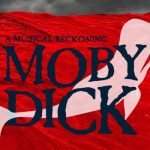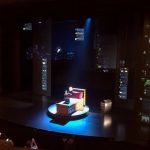Ivo van Hove’s revival of West Side Story is officially in previews, and last Thursday I saw the third preview. Since the show will be in previews for a period of almost two months, I will take a similar approach to talking about this show as I did with Sing Street. I will take a few elements of the production as an example to try and analyze what the creators want to achieve with this production. However, since West Side Story is an existing property with book and lyrics that are established, and since I have never seen the movie or a production of West Side Story I have nothing to compare the show to and therefore the blog will seem more review-like in nature. Just remember that any of the elements I am talking about are subject to change in the two-month preview-period.
Revival
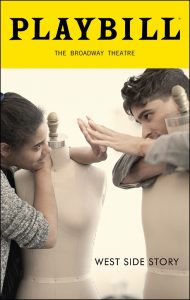
Let’s get something out of the way first. This is not a revival of West Side Story, this is Ivo van Hove’s revival of West Side Story. They are not trying to retell the original story, but they are trying to tell the original story. What I’m getting at is this: this show will in no way compare to any other version because it is a new product merely using the same ingredients. If you go in expecting the classic from the ‘50’s you are in for a wild ride.
Ivo irrevocably sets the story in current-times. Modern dress is used and the sets reflect the update. He has cut out the intermission along with some songs that created the two-act structure (mainly ‘I feel Pretty’ and the ‘Somewhere’ ballet). Ivo has admitted to these choices in multiple interviews and he explains that he did it to build up the tension. The story, after all, takes place over the course of about 48 hours. That is a very short period and Ivo wanted to represent that by not taking a break and not letting the audience settle in.
That last part is quite literal as the show started while a pretty sum of people were still being led to their seats by ushers. Ivo wants to let the audience feel the rush of the story, and I get that, but the problem is that the original production has no room for that. He has already cut two songs to accomplish that but I feel that Ivo needs to cut even more to really reach his goal. Right now there are still production numbers like ‘Gee officer Krupke’ that stand in the way of feeling the intimate dread in the relationship between Tony and Maria.
Staging
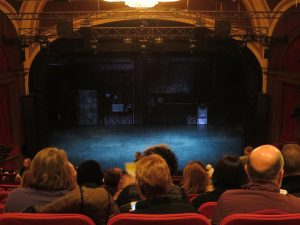
A big part of how Ivo decides to stage the show is Jan Versweyveld’s scenic- and lighting design and Luke Halls’ video design. Jan Versweyveld is a mainstay for Ivo van Hove and Luke Halls’ video design also fits in perfectly with Ivo’s earlier work. Ivo as a post-dramatic theatre director is a fan of exposing the world of the theater to create a consciousness in his audience. By becoming aware that they are seeing events unfolding live, they become more aware of the text and the acting. This show is no difference as the theatre space is all but empty and when some form of set comes into play he uses the staircase of the actual theatre and two rooms that are fully-realized, only made visible due to multiple camera’s. What we see most of the times is the huge backwall that is used as a screen. We jump-cut from real-life scenes of New York City to a live feed by two camera-men on stage and then back to outside shots. For those uninitiated to van Hove’s work this might feel disorientating, especially because the theater-space is so immense. By projecting some of the dialogue scenes in gigantic close-ups you start to lose track of who is saying what on stage in front of that close-up. The near-constant and unexpected movement of the camera through the actual shots of New York also sometimes detract from the scene. For example: most of the times the camera stays steady, as if it were slowly walking down an ally, but then it suddenly takes a turn left and it seems to move the stage with it. Ivo and Luke Halls really need to fine-tune this before opening night, because the video should create an extra layer, and focus, not distract.
There is, however, one scene in which Luke Halls’ video design and Jan Versweyveld’s lighting design work perfectly together, and that is the gym scene. The Jets and the Sharks are at a dance, they are physically separated by space and dance in two groups. Since the stage space is very large they are cleary separated. Jan lights the two competing, dancing, gangs in two distinct colors: Red and Blue. Luke Halls has two cameramen film both groups separately and he then layers both on top of each other on the screen creating a very interesting contrast to the scene on the stage. Because whilst the actual gangs are physically separate, on the screen they are already fighting one another.
Choreography
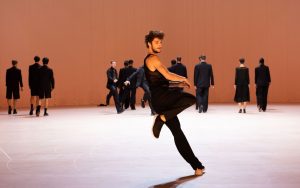
The most shocking change to most West Side Story-purists, besides maybe not utilizing the iconic fire-escapes, is the fact that Ivo van Hove has opted to throw out Jerome Robbins’ original choreography. Even more surprising is the choice he made in hiring the new choreographer: Anne Teresa de Keersmaeker. Although they are both theater-creatives from Belgium with a passion for subversion, they haven’t overtly collaborated much. Anne sticks mostly to Dance. I had the honor of seeing her work ‘Six Brandenburg Concertos’ in the Theatre Royal Carré in Amsterdam just last year, and it surprised me in a good way. Anne’s dance-group ‘Rosas’ and her dance-project ‘Rosas danst Rosas’ are renowned around the world, so much so that Beyoncé lovingly ripped the ‘Rosas danst Rosas’ choreography off for a video of hers.
West Side Story is, in contrast to all of that, her theatrical debut. For the first time she is choreographing a piece that has to tell a story whilst being in another story-telling device: text-based musical theater. You can clearly the seams, in this production, where they are trying to make her particular style fit with the form. At times, the choreography tells a story that is conflicting with the main-story, or it presents something so chaotic it detracts from the visual story altogether. But there are times, like the aforementioned Gym-scene in which the choreography shines. Using elements of Jerome’s ballet-like-choreography whilst finding a way to break the mental patterns that the ballet creates. The most perfect moment Anne presumably created isn’t even part of a dance-sequence. It is the ending of the song ‘Tonight,’ the dialogue between Tony and Maria is expressing the fear they both have for the fact that they are from opposing teams. To add to that fear, to visualize it, they have both gangs physically trying to tear the two lovers apart.
Collaborative effort that needs fine-tuning
What becomes very clear when viewing the show, as I describe in the sections above, is that there are a lot of competing creative forces at work. You can see that all of these creators are trying to tell the story in the best of their ability, in a way that fits most with Ivo’s vision, but a big part of the creative ideology of the show seems to be that every creative element needs to stand on their own. They are separate layers of meaning that convey the same story. The set isn’t functional, it’s a story-telling device, so is the choreography: it’s not beautiful twirls set to music they are movements that convey the emotions of the story. For example: the scenic design isn’t just there to create a physical space, it’s there to tell the story, therefore Jan Versweyveld chooses between razor-sharp reality in his sets and artistic license in other moments.
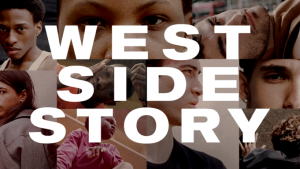
Take for example the ‘Rumble’ scene. The story takes place underneath a highway, but instead of introducing physical elements to tell that he hands us distinct breadcrumbs. The familiar orange-lighting of New York’s streetlamps, the near-constant rain and quick flashes. Jan is trying, in his own way, to add to the tension, by removing physical signifiers and creating a setting that is recognizable in the feel rather than in the familiarity. This particular scene is an example of when the creative forces work well together, the scenic design helps Anne’s choreography and Ivo’s blocking because it takes place spread-out on the entire stage space and the scenic design allows for that. Even Luke Halls’ video-design takes a step back in this scene to create focus. However there are scenes in the show that naturally lend themselves to giving the actual storytelling, the text and the acting, more focus. When they then add the other layers of meaning that tell the same story, some elements seem redundant or distracting.
Conclusion
Ivo van Hove along with his creative team is doing experiments on one of America’s greatest golden-age musicals. The work they are doing is inspiring in that it paves the way for other interpretations of this story or other stories, breaking down the sacred wall of ‘classic status’ by tearing away the original choreography and other elements. However, the elements that they put in their place have to fit with the material and the visual language they are creating. There are still moments in the show where I felt that they were missing the mark. Luckily they still have two entire months to go before opening night and they can tweak these things. But altogether I am very excited for what this bold new take could mean for the future of Broadway revivals. Give me West Side Story 2019 and Oklahoma 2019 over the My Fair Lady’s and Les Miserables’s any day.
Seen on : 12/12/2019 at the Broadway Theater, NY. Directed by Ivo van Hove, scenery and lighting design by Jan Versweyveld, costume design by An d’Huys, sound design by Tom Gibbons, video design by Luke Halls, orchestrations by Jonathan Tunick. music supervisor / musical director: Alexander Gemignani.
